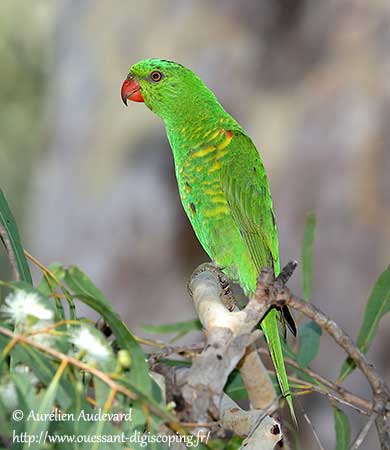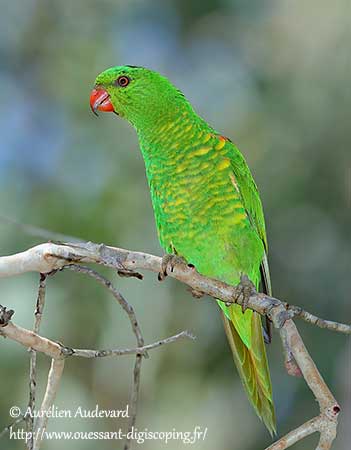
Fr: Loriquet vert
Ang: Scaly-breasted Lorikeet
All: Schuppenlori
Esp: Lori Escuamiverde
Ita: Lorichetto pettosquamato
Nd: Schubbenlori
Sd: gulvattrad lorikit
Photographers:
Aurélien Audevard
OUESSANT DIGISCOPING
Jean Michel Fenerole
Photos d’Oiseaux du monde
Ken Havard
My Bird Gallery & Flickr gallery 1 & Flickr gallery 2
Patrick Ingremeau
TAMANDUA
Text by Nicole Bouglouan
Sources:
HANDBOOK OF THE BIRDS OF THE WORLD volume 4 by Josep del Hoyo, Andrew Elliot and Jordi Sargatal – LYNX EDICION – ISBN 8487334229
PARROTS OF THE WORLD – An Identification Guide – by Joseph M. Forshaw – Princeton University Press – ISBN 0691092516
Birds in backyards (Birds Australia and Australian Museum)
Wikipedia, the free encyclopaedia
Scaly-breasted Lorikeet
Trichoglossus chlorolepidotus
Psittaciformes Order – Psittaculidae Family
INTRODUCTION:
The Scaly-breasted Lorikeet is found in the woodlands of the coastal regions of eastern Australia, up to 600 metres of elevation.
It feeds on nectar and pollen harvested from several plant species, but fruits and seeds are also part of the diet. It typically nests in natural cavities, often tree holes. Both adults share most of nesting duties, but the female alone incubates the eggs.
The Scaly-breasted Lorikeet is not globally threatened for the moment.
DESCRIPTION OF THE BIRD:
Biometrics:
Length: 23 cm
Weight: 75-95 g
The Scaly-breasted Lorikeet has green plumage overall, scalloped yellow on hindneck and upper mantle, and below from breast to flanks. On the underwing, the coverts and a broad underwing band at base of the flight-feathers are orange-red, brighter on coverts. The broad trailing edge is dark grey. The undertail is yellowish-green.

The head is green without markings.
The bill is coral-red. The eyes are orange-yellow with dark grey eyering. Legs and feet are grey-brown.
Male and female are similar.
The juvenile shows less yellow scalloping. The bill is dusky brown. The eyering is paler grey. Legs and feet are paler brown.
RANGE:
The Scaly-breasted Lorikeet is found in eastern Australia, from the tip of Cape York in N Queensland, S to Wollongong in New South Wales.
The species was introduced to Melbourne district, S Victoria.
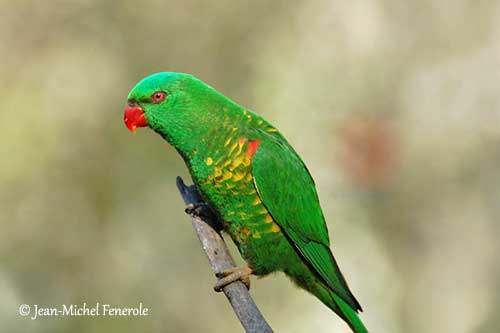
HABITAT:
The Scaly-breasted Lorikeet frequents the lowland eucalypt forests and other types of wooded areas, also urban parks and gardens. It occurs in cultivated lands with flowering trees, Melaleuca swamps and littoral shrubland with Banksia tree species. It can be seen up to 600 metres of elevation.
CALLS AND SONGS: SOUNDS BY XENO-CANTO
The Scaly-breasted Lorikeet gives screeching call-notes usually higher-pitched than those of the Rainbow Lorikeet.
These calls are described as “skheel”, or “klee” and “kha-kha”.
BEHAVIOUR IN THE WILD:
The Scaly-breasted Lorikeet feeds on nectar and pollen from various plant species including Eucalypts, Melaleucas, Callistemons and Banksias.
Fruits are taken in orchards and gardens, and it also feeds on seeds from Umbrella trees and other native trees and shrubs.
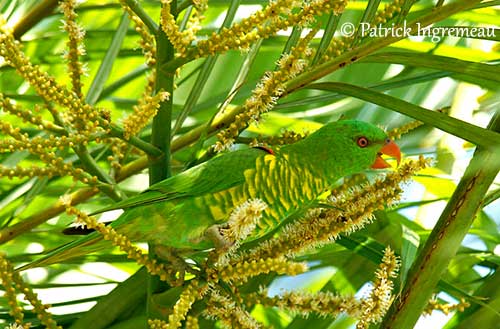
It usually moves in large, noisy flocks, especially when feeding. They may join flocks of Rainbow Lorikeets.
They are mainly active in the morning, following the departure from the communal nightime roosts, and again in late afternoon, prior to the return to the roost.
The Scaly-breasted Lorikeet nests in hollow limb or in hole formed by a broken branch against the trunk. Both adults arrange the nesting cavity by chewing off pieces of wood. This work is very long and may last up to six weeks.
This species is locally nomadic. These movements are closely related to flowering periods. Some populations are sedentary, mainly in urban districts where the birds regularly feed in gardens and orchards.
The flight is swift and direct. The sound of their rapid wingbeats is often heard along with the high-pitched calls given in flight.
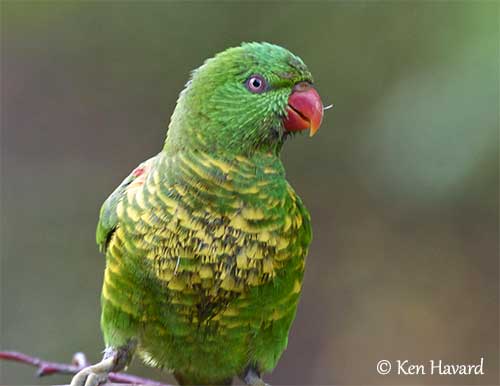
REPRODUCTION OF THIS SPECIES:
The breeding season takes place between May and February in the northern part of the range where it is related to rainfall. In Victoria, this period occurs in August. But breeding may occur in all months, except March and April.
The Scaly-breasted Lorikeet nests in natural cavities, mainly hollows in trees, in hollow limbs or in the hole formed by a broken branch against the trunk of a eucalypt tree. The nest is usually high, between 3 and 25 metres above the ground.
Both adults often modify the hollow by chewing off pieces of wood. This work may last up to six weeks.
The female lays 2-3 white eggs on a bed of decayed wood on the bottom of the cavity. She incubates alone during 25 days. She is fed on the nest by the male. The young are fed by both parents. They fledge about two months after hatching.
PROTECTION / THREATS / STATUS:
The Scaly-breasted Lorikeet is described as common in the centre, and rarer towards both northern and southern parts of the range.
Any declines or substantial threats are currently known, and the population is suspected to be stable.
The Scaly-breasted Lorikeet is not globally threatened and currently evaluated as Least Concern.
